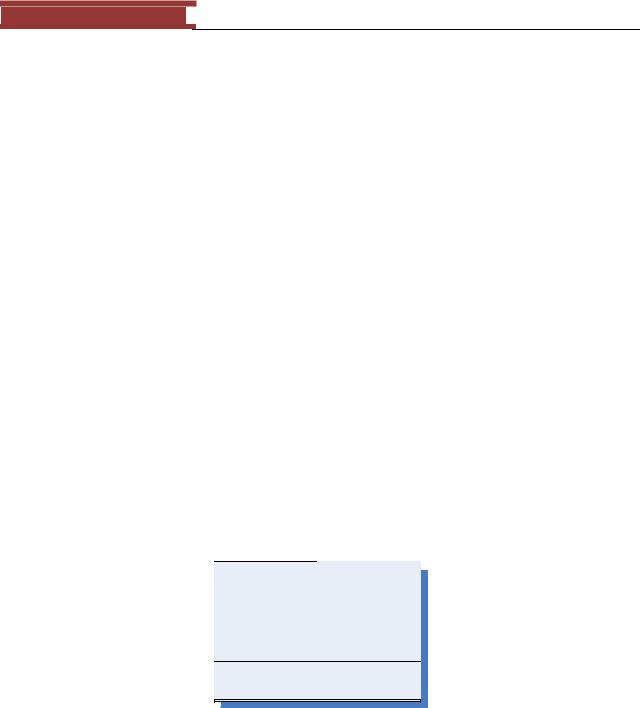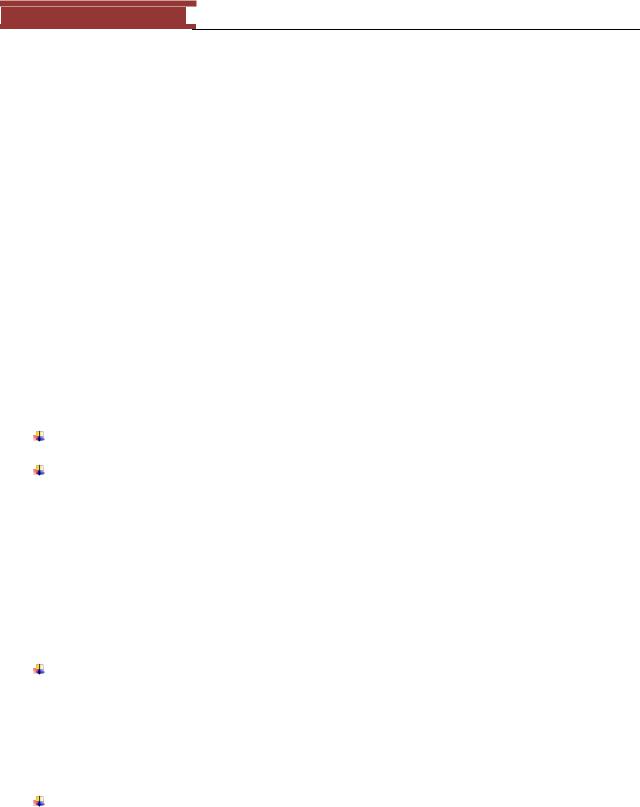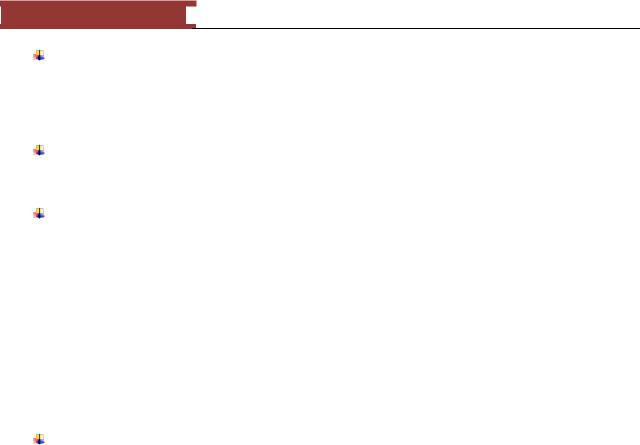
LearningSDL011
.pdf
December 15, 2011 [LEARNING SDL – A BEGINNER’S GUIDE]
[LEARNING SDL – A BEGINNER’S GUIDE]
The problem with all these variables is that all the ones starting with the word paddle_ and ball_ are all related to the same objects in our game. We try to remind ourselves of the connection and relationship by prefixing all the variables with the same name. Suppose we wanted to create and use a function to initialize the paddle.
void initializePaddle( int& paddle_x, int& paddle_y, int& paddle_width, int& paddle_height, int& paddle_color ) {
paddle_x = <middle of the screen>; paddle_y = <bottom of the screen>; paddle_width = PADDLE_WIDTH; paddle_height = PADDLE_HEIGHT; paddle_color = cWHITE;
}
You may wonder if there isn‘t some better way to package all these related variables. There is.
C++ provides a better way to package and organize variables that relate to the same object. C++ introduces a construct called struct.
A struct is another word for record. A struct allows us to group different data types together under one name. The struct will be used in our programs as a new data type. I conceptualize a struct like a special box I create with compartments. First we create a template (think cookie cutter) for the struct. This struct definition is used to create many other copies. Each copy will have its own name.
A visual example to help conceptualize the idea of a struct is to imagine we create a template box as shown below:
x Y
color
Figure 114 - visual representation of struct definition shapeStruct
The template box represents our struct definition. We may give this a name, for example, shapeStruct. This struct is composed of three variables x, y and color. We can now create two new actual variables, paddle and ball based on this shapeStruct we just defined.
151

December 15, 2011 [LEARNING SDL – A BEGINNER’S GUIDE]
[LEARNING SDL – A BEGINNER’S GUIDE]
x |
Y |
x |
Y |
color color
ball paddle
Figure 115 - Creating two structs using our template
The new variables ball and paddle each have the same three components or variables contained in them - x, y and color. We can distinguish it by using the following syntax:
ball.x
ball.y
ball.color
Same thing for paddle:
paddle.x
paddle.y
paddle.color
Note how we first use the name of our struct element (ball, paddle) and then specify the actual element within the struct by using ‗.‘ And the struct member name (x, y, or color).
We can put things into the struct :
ball.x = 20; // set the x position of the ball ball.y = 5; // set the y position of the ball ball.color = cBLUE;
We can extract or use the contents of the record:
setCursorPos( ball.x, ball.y); |
// |
set the cursor at the current location |
|
// |
of the ball |
The actual C++ syntax for defining a struct is:
struct <structname> { dataType1 memberName1; dataType2 memberName2;
:
152

December 15, 2011 [LEARNING SDL – A BEGINNER’S GUIDE]
[LEARNING SDL – A BEGINNER’S GUIDE]
dataType3 memberNameN;
};
The members of a struct can consist of basic data types (e.g. int), other structs, or arrays. The struct definition does not reserve any memory space. You will need to create struct variables in order to reserve space.
For example we create a new structured data type named paddleType. We will use this new data type to create a variable to represent our paddle.
struct paddleType { |
|
|
|
int x; |
// indicates |
the top_left |
x position on the screen; |
int y; |
// indicates |
the top_left |
y position on the screen; |
int width; |
// indicates |
the width of |
the paddle |
int height; |
// indicates |
the height of the paddle |
|
int color; |
// the color |
of the paddle |
|
}; |
|
|
|
Now to create a paddle variable requires that we declare it:
paddleType paddle;
The variable paddle is a struct. It contains all the components we see in the definition of paddleType. So we now use paddle.x, paddle.y, paddle.width, paddle.height, and paddle.color.
The function we created earlier to initialize a paddle now can be created more concisely as:
void initializePaddle( paddleType& paddle ) { paddle.x = <middle of the screen>; paddle.y = <bottom of the screen>; paddle.width = PADDLE_WIDTH; paddle.height = PADDLE_HEIGHT; paddle.color = cWHITE;
}
Doesn‘t it look more organized? We collected all the attributes of a paddle into one component called a struct. We don‘t have to send around all the various pieces just the one struct variable named – paddle. The variable paddle consists or contains all the pieces for us. We pass the paddleType struct to the function by reference, that is, we send the address of the struct paddle to the function so that its members can be initialized.
153

December 15, 2011 [LEARNING SDL – A BEGINNER’S GUIDE]
[LEARNING SDL – A BEGINNER’S GUIDE]
You can create the variables the same time you create the struct definition by using this format:
struct <structname> { dataType1 memberName1; dataType2 memberName2;
:
dataType3 memberNameN;
} <structVariable1>, <structVariable2, . . . , <structVariableN>;
This is how we could have defined the struct for paddleType and created two player paddles.
struct paddleType { |
|
|
|
int x; |
// indicates |
the top_left |
x position on the screen; |
int y; |
// indicates |
the top_left |
y position on the screen; |
int width; |
// indicates |
the width of |
the paddle |
int height; |
// indicates |
the height of the paddle |
|
int color; |
// the color |
of the paddle |
|
} paddlePlayer1, paddlePlayer2;
In summary
We use a struct to help us group related variables
We first create the struct definition
o this does not allocate any memory
o the struct definition MUST end with a semicolon o this merely creates a template for us to use
othe components of the struct are called members of the struct
Example: x, y, width, height, and color are members of the struct paddleType
We then create struct variable
oto create or declare variables based on the struct we use the format:
< structname > <variablename>
Example: paddleType paddle;
We then treat each struct member as a variable
oto access struct members (the x, y and color, etc) we use the following format:
<variablename>.<membername>
Example: paddle.color
154

December 15, 2011 [LEARNING SDL – A BEGINNER’S GUIDE]
[LEARNING SDL – A BEGINNER’S GUIDE]
The struct members can have different data types, this is what makes struct a heterogeneous data type, that is, you can have a mix of int, char, double, string, etc. whatever makes sense to what you are building.
Things you can do with structs
You can initialize a struct when you creat it
PaddleType myPaddle = { 0, 0, 10, 40, cBLUE };
Assign one struct variable to another
// create |
two paddleType struct variables |
|
|
||
paddleType player1, player2; |
|
|
|
||
initializePaddle( player1 ); |
// Initialize player 1 |
paddle |
|||
player2 = |
player1; |
// Assign player2 |
the values |
in player1 |
|
The example above creates two struct paddleTypes for player1 and player2. The initializePaddle will initialize the members of player1. The assignment statement will copy all the member values in player1 to player1. If the initialization put the value cWHITE into player1.color then after the assignment player2.color will have the same value. Neat!
You can create a struct that has another struct within it.
Suppose we have a struct named COORD that holds the x and y coordinate of any object that we display on the screen.
struct COORD { int x; int y;
};
We may want to re-use the struct COORD that is already defined in your own new struct that represents the paddle:
struct paddleType2 { |
|
|
|
COORD screenLocation; |
// the screen location of the paddle |
||
int width; |
// |
indicates |
the width of the paddle |
int height; |
// |
indicates |
the height of the paddle |
int color; |
// |
the color |
of the paddle |
}; |
|
|
|
This new definition for a paddle will require that access to the x and y values that represent the top-left position of the paddle on the screen will need to change.
paddleType2 playerPaddle; |
// create a variable for the player |
|||
playerPaddle.screenLocation.X = 0; |
// |
set |
x |
location |
playerPaddle.screenLocation.Y = 10; // |
set |
y |
location |
|
155

December 15, 2011 [LEARNING SDL – A BEGINNER’S GUIDE]
[LEARNING SDL – A BEGINNER’S GUIDE]
Note the difference between how x and y values are accessed, you need to use the struct variable name (playerPaddle), the variable name that is a struct itself (screenLocation) and then the actual variable name (X) within that struct.
Things you can’t do with structs
You can‘t compare one struct variable with another. So if you had the following declaration:
paddleType player1, player2;
:
:
// can’t do this
if ( player1 == player2 ) {
}
You would need to compare the members of player1 and player2 member by member:
if ( player1.x == player2.x && player1.y == player2.y ) {
}
You can‘t read or write into a struct variable as one entity
paddleType player1;
cin >> player1; // not allowed cout << player1; // not allowed
Again, you will need to input/out into the members of a struct.
cin >> player1.x >> player1.y;
cout << “Player 1 paddle.x = “ << player1.x << endl; cout << “Player 1 paddle.y = “ << player1.y << endl;
Using typedef with structs
A typedef allows us to associate another name or an alias with a struct. The alias is usually shorter and easier to use than the original name. The format is:
typedef [attributes] <datatype> <aliasName>;
One will typically simple uses of typedef such as:
typedef int km_per_hour; typedef unsigned char Uint8; its use in your program:
km_per_hour current_speed; km_per_hour new_speed;
156
Figure 116 - Is there any difference?

December 15, 2011 [LEARNING SDL – A BEGINNER’S GUIDE]
[LEARNING SDL – A BEGINNER’S GUIDE]
In C you would have to use the actual keyword struct when declaring a struct variable, for example:
struct paddleType myPaddle;
to avoid that C programmers are in the habit of providing an alias for the entire struct so they can declare variables without having the specify the term struct.
A typical use of this style is the declaration of SDL_Color struct in the sdl_video.h:
typedef struct SDL_Color { Uint8 r;
Uint8 g; Uint8 b; Uint8 unused;
} SDL_Color;
The above creates the alias SDL_color for the struct SDL_color structure. So in C or C++ or you would need to do to declare a variable of SDL_color is the follow declaration:
SDL_color myColor;
157

December 15, 2011 [LEARNING SDL – A BEGINNER’S GUIDE]
[LEARNING SDL – A BEGINNER’S GUIDE]
Appendix F – Pointers
When a programmer declares a variable:
int aNumber;
we don‘t think too much about the fact that when we use the name aNumber that we are actually referencing the memory address where our (let‘s say) 32-bit int is being stored:
158

December 15, 2011 [LEARNING SDL – A BEGINNER’S GUIDE]
[LEARNING SDL – A BEGINNER’S GUIDE]
SDLKey |
|
SDL_ActiveEvent |
|
SDL_AddTimer |
|
SDL_AudioCVT |
|
SDL_AudioSpec |
|
SDL_BlitSurface |
Chapter 2 |
SDL_BuildAudioCVT |
|
SDL_CD |
|
SDL_CDClose |
|
SDL_CDEject |
|
SDL_CDName |
|
SDL_CDNumDrives |
|
SDL_CDOpen |
|
SDL_CDPause |
|
SDL_CDPlay |
|
SDL_CDPlayTracks |
|
SDL_CDResume |
|
SDL_CDStatus |
|
SDL_CDStop |
|
SDL_CDtrack |
|
SDL_CloseAudio |
|
SDL_Color |
Chapter 2 |
SDL_CondBroadcast |
|
SDL_CondSignal |
|
SDL_CondWait |
|
SDL_CondWaitTimeout |
|
SDL_ConvertAudio |
|
SDL_ConvertSurface |
Chapter 2 |
SDL_CreateCond |
|
SDL_CreateCursor |
|
SDL_CreateMutex |
|
SDL_CreateRGBSurface |
|
SDL_CreateRGBSurfaceFrom |
|
SDL_CreateSemaphore |
|
SDL_CreateThread |
|
SDL_CreateYUVOverlay |
|
SDL_Delay |
Chapter 2 |
SDL_DestroyCond |
|
SDL_DestroyMutex |
|
SDL_DestroySemaphore |
|
SDL_DisplayFormat |
Chapter 2 |
SDL_DisplayFormatAlpha |
Chapter 2 |
SDL_DisplayYUVOverlay |
|
SDL_EnableKeyRepeat |
|
SDL_EnableUNICODE |
|
SDL_Event |
|
SDL_EventState |
|
SDL_FillRect |
Chapter 2 |
|
159 |

December 15, 2011 [LEARNING SDL – A BEGINNER’S GUIDE]
[LEARNING SDL – A BEGINNER’S GUIDE]
SDL_Flip |
Chapter 2 |
SDL_FreeCursor |
|
SDL_FreeSurface |
Chapter 2 |
SDL_FreeWAV |
|
SDL_FreeYUVOverlay |
|
SDL_GL_GetAttribute |
|
SDL_GL_GetProcAddress |
|
SDL_GL_LoadLibrary |
|
SDL_GL_SetAttribute |
|
SDL_GL_SwapBuffers |
|
SDL_GLattr |
|
SDL_GetAppState |
|
SDL_GetAudioStatus |
|
SDL_GetClipRect |
|
SDL_GetCursor |
|
SDL_GetEventFilter |
|
SDL_GetGamma |
|
SDL_GetGammaRamp |
|
SDL_GetKeyName |
|
SDL_GetKeyState |
|
SDL_GetModState |
|
SDL_GetMouseState |
|
SDL_GetRGB |
|
SDL_GetRGBA |
|
SDL_GetRelativeMouseState |
|
SDL_GetThreadID |
|
SDL_GetTicks |
Chapter 2 |
SDL_GetVideoInfo |
Chapter 2 |
SDL_GetVideoSurface |
|
SDL_Init |
Chapter 2 |
SDL_InitSubSystem |
Chapter 2 |
SDL_JoyAxisEvent |
|
SDL_JoyBallEvent |
|
SDL_JoyButtonEvent |
|
SDL_JoyHatEvent |
|
SDL_JoystickClose |
|
SDL_JoystickEventState |
|
SDL_JoystickGetAxis |
|
SDL_JoystickGetBall |
|
SDL_JoystickGetButton |
|
SDL_JoystickGetHat |
|
SDL_JoystickIndex |
|
SDL_JoystickName |
|
SDL_JoystickNumAxes |
|
SDL_JoystickNumBalls |
|
SDL_JoystickNumButtons |
|
SDL_JoystickNumHats |
|
SDL_JoystickOpen |
|
|
160 |
